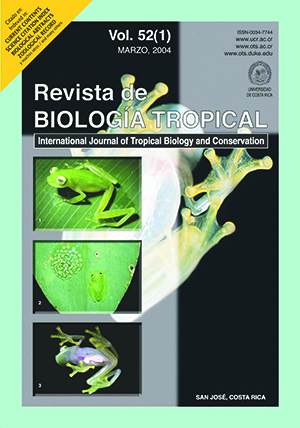Abstract
This study describes the results and collection practices for obtaining arthropod samples to be studied as potential sources of new medicines in a bioprospecting effort. From 1994 to 1998, 1800 arthropod samples of 6-10 g were collected in 21 sites of the Área de Conservación Guancaste (A.C.G) in Northwestern Costa Rica. The samples corresponded to 642 species distributed in 21 orders and 95 families. Most of the collections were obtained in the rainy season and in the tropical rainforest and dry forest of the ACG. Samples were obtained from a diversity of arthropod orders: 49.72% of the samples collected corresponded to Lepidoptera, 15.75% to Coleoptera, 13.33% to Hymenoptera, 11.43% to Orthoptera, 6.75% to Hemiptera, 3.20% to Homoptera and 7.89% to other groups. Different life stages per arthropod species were obtained in most samples, 54.26% of them were adults, 19.90% corresponded to larvae, 6.46% to pupae, 6.12% to pre-pupae, 2.07% to nymphs and 3.74% to other stages. Other materials associated to insects like frass represented 11.20% of the samples collected. Several collecting methods were explored, based on the possibility of accessing the necessary amount of material causing the less impact. Most of the samples were obtained by manual collection (44.38%), followed by insects breeding (25.73%), light traps (18.80%), different types of nets (10.52%) and other methods (0.16%). In general, collecting methods and practices excluded the use of solvents, mixing different species or life stages in the same bag, which might have introduced undesirable effects in the screening systems for new compounds. Based on the possibility of finding new chemicals in similar samples associated to one arthropod species, the collecting strategy included the generation of several samples from same species, separated according to differences in life stages, collecting sites, ecosystems, seasons, feeding materials or behavioral aspects. This strategy allowed the generation a larger number of samples submitted to bioassays in different areas of pharmaceutical research.
References
Barboza, P. & D.K. Letourneau. 1988. Novel Aspects of Insect-Plant Interactions. Wiley. 362 p.
Chinchilla Carmona, M., M. Herrera Corrales, O.M. Guerrero Bermúdez, A. Jiménez Somarribas, G. Tamayo, A. Sittenfeld Appel, V. Nielsen & P. Hurtado. 2003. Efecto de extractos de artrópodos sobre la multiplicación del Toxoplasma gondii dentro e macrófagos peritoneales de ratón. Rev. Biol. Trop. 51: 317-320.
De la Fuente, J. 1994. Zoología de Artrópodos. Mc- Graw-Hill-Interamericana, Madrid, España.
Demain, A.L. 1998. Microbial natural products: alive and well in 1998. Nature Biotechnology 16: 3-4.
Dillon, R.J., C.T. Vennard & A.K. Charnley. 2000. Exploration of gut bacteria in the locust. Nature 403: 851.
Maes, J.M. 1998. Catálogo de los insectos y artrópodos terrestres de Nicaragua. Vol. 1. Print-León, Nicaragua. 485 p.
Mateo, N. 1996. Wild Biodiversity: The Last Frontier? The Case of Costa Rica. The Globalization of Science: The Place of Agr. Res. 73-82 p.
Mateo, N., W. Nader & G. Tamayo. 2001. Bioprospeting. Encyclopedia of Biodiversity, Volume 1. Academic, New York. pp. 471-488.
Moreno, E. 1997. In search of a bacterial species definition. Rev. Biol. Trop. 45: 753-771.
Nielsen, V. 2003. Métodos para colectar insectos. Rev. Agron. Trop. 33: 59-68.
Obando, V. 2002. Biodiversidad de Costa Rica: estado del conocimiento y gestión. Editorial INBio, Santo Domingo de Heredia, Costa Rica. 17 p.
Rosenthal, J. 2002. Curtain has fallen on hopes of legal bioprospecting. Nature 416, 15.
Setzer, M.C., D.M. Moriarity, R.O. Lawton, W.N. Setzer, G.A. Gentry & W.A. Haber. 2003. Phytomedicinal potential of tropical cloudforest plants from Monteverde, Costa Rica. Rev. Biol. Trop. 51: 647- 674.
Sittenfeld, A. & R. Villers. 1993. Exploring and Preserving Biodiversity in the Tropics: The Costarrican Case. Current Opinion. Biotechnol. 4: 280-285.
Sittenfeld, A. 1996. Issues and strategies for bioprospecting. Genetic Engineering and Biotechnology UNIDO, Emerging Technology Series 4: 1-12.
Sittenfeld, A., & A. Lovejoy. 1996. Biodiversity Prospecting Frameworks: The INBio Experience in Costa Rica. Protection of global biodiversity: Converging Strategies pp. 223-244.
Sittenfeld, A. , G. Tamayo, V. Nielsen, A. Jiménez, P. Hurtado, M. Chinchilla, 0. Guerrero, M. A. Mora, M. Rojas, R. Blanco, E. Alvarado, J.M. Gutiérrez, & danzen. 1999. Costa Rican international cooperative biodiversity group: using insects and other arthropods in biodiversity prospecting. Pharm. Biol. 37(Suppl.): 55-68.
Comments

This work is licensed under a Creative Commons Attribution 4.0 International License.
Copyright (c) 2004 Revista de Biología Tropical


